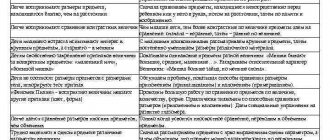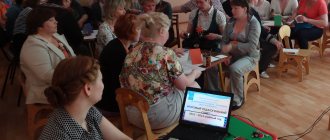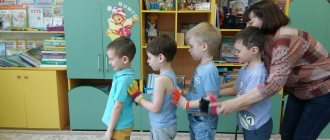Modern trends in preschool education
In accordance with the decision of the Council, the draft Federal State Educational Standard for preschool education was finalized and submitted for re-consideration. Based on the conclusions of 11 expert organizations and the recommendations of the working group of general education, the Council of the Ministry of Education and Science of the Russian Federation on federal state educational standards on August 28, 2013 decided to approve the Federal State Educational Standard for preschool education .
The introduction of the Federal State Educational Standard for Educational Education into practice will require the implementation of a number of activities, determining their nature and sequence.
Modern trends in the development of preschool education must first of all include:
Humanization of education – consideration of the child’s personality as the highest value of society, emphasis on the formation of a citizen with high intellectual, moral and physical qualities. And although the principle of humanization is one of the traditional general didactic principles, at the present stage of development of education its implementation is ensured by other conditions, first of all, the complexity of traditional and new trends in the functioning of the educational system.
Individualization as an effort is another traditional didactic principle of the need for an individual approach.
The implementation of this principle is manifested, first of all, in the organization of a personal-activity approach in education. The emergence of such an integrated, systematic approach to the upbringing and education of children is due not only to the natural development of pedagogical science, which, like any area of human activity, is characterized by a constant desire for progress, but also to the urgent crisis of the existing education system. A feature of this approach is the consideration of the learning process as a specific form of subjective-subjective relations between teacher and student. The very name of this approach emphasizes the relationship between its two main components: personal and activity.
The personal (or personality-oriented) approach assumes that the student with his individual psychological, age, gender and national characteristics is at the center of learning. Within the framework of this approach, training should be built taking into account the individual characteristics and “zone of proximal development” of the student. This consideration is manifested in the content of educational programs, forms of organization of the educational process and the nature of communication.
The essence of the activity component is that education contributes to the development of the individual only if it encourages him to take action. The significance of the activity and its result influences the effectiveness of a person’s mastery of universal human culture. When planning educational activities, it is necessary to take into account not only the general characteristics of the activity (objectivity, subjectivity, motivation, purposefulness, awareness), but also its structure (actions, operations) and components (subject, means, methods, product, result).
Without the cult of the teacher. 10 trends in private preschool education
Zhanna Kazanskaya
Why do some parents send their children to private kindergartens and what do they expect? The reasons may be different, but, as a rule, parents are confident that in a private kindergarten there will be a higher quality of education, and most importantly, an individual approach to the child (groups there are not 25 people). The founder of a network of private kindergartens, Zhanna Kazanskaya, talks about the main trends in the field of private preschool education.
Useful Mela newsletter twice a week: Tuesday and Friday
SUBSCRIBE
If we look at the results of 2022, we can say that the market for children's services and goods is developing quite actively. If we talk about education, then a large number of private children's educational projects are emerging - both in the center of Moscow and in residential areas and especially cottage villages, where the demand for them is quite high. In terms of leisure time, children's infrastructure also does not stand still and develops on a par with adults. For example, shopping centers have become more and more active in offering options for entertainment and educational programs for children, and devoting more and more space to the children's area.
The only task is to figure out what will be most in demand.
If we talk about private gardens, their format and content are completely different: from full-fledged ones - with their own kitchen and area for walking - to tiny leisure centers for children's day care.
This recent growth is due to several reasons. Firstly, entrepreneurs realized that the children's niche is extremely promising, and secondly, the positive dynamics are associated with the increased interest of parents and the penetration of business processes into this area.
Today in Moscow, 8% of parents use the services of private kindergartens. This figure is quite large, considering the fact that several years ago this figure was reduced to only 1-2%. There are approximately 800 private gardens in the capital, and there are prospects for growth.
Modern parents are becoming more and more demanding regarding private preschool education
Their requests priorities change. Being inside the market, we tried to highlight the main trends in the development of private kindergartens that could be observed this year.
Main trends in the development of private kindergartens
1. The concept of gardens, in which conditions are as close as possible to home ones, is actively gaining popularity
. The number of children in them is limited to 10. This is due to the desire of parents to provide their child with comfort and safety, and most importantly, the attention of educators.
2. Refusal of private gardens from an oversaturated and super-intensive program towards a modular approach
. This allows the child to choose what to do, and teachers to take into account and reveal his individual characteristics. Today, parents are most interested in activities that are related to the development of the child’s emotional intelligence. The focus is on the period of “preschool childhood” itself and the child’s full experience of it, and not just the stage of preparation “for the future life.”
3. The emergence of many original educational methods in private gardens.
Today, parents give priority to combined programs that combine several approaches from different schools (Maria Montessori, Cecile Lupan, Waldorf, etc.).
4. Owners of private gardens are looking for teachers of a new format
. The idea of the “cult” of the teacher is gradually being destroyed. Managers strive to offer a unique system of knowledge, and this requires teachers who are ready and willing to work in a team.
5. Private gardens are actively developing additional services
. They can be used not only by pupils, but also by parents who want to get acquainted with the institution or cannot afford to pay for a child’s daytime visit. A large number of sections, clubs and classes appear. These are art lectures, sports sections, language classes, etc.
6. Children have become different over the past three to five years.
They live in another world, where the speed of transmitting and receiving information is very high. If a child needs to know something, he just needs to type a question in a search engine, and he will instantly receive an answer. Something must motivate the child to search for this knowledge; interest must awaken in him.
The relevance of the problems of modern preschoolers
Municipal autonomous preschool educational institution of the Korolev urban district, Moscow region
“General developmental kindergarten No. 38 “Rainbow”
141080, Moscow region, city Korolev, Makarenko proezd, building 4, telephone
141076, Moscow region, city. Korolev, Michurina street, building 21G, phone:8(495)519-13-23
“the relevance of the problems of modern preschoolers”
Completed:
Tambova S.V.
Korolev 2022
- Modern trends in preschool education 7 pp.
- Prospects for the development of preschool education in Russia 10 pages
- Conclusion 12 pages
- Bibliography 13 pages
.
Introduction
The relevance of preschool education in Russia has, and will continue to have, popularity, since for modern society the strategy of forming a system that would ensure the comprehensive education and development of children from birth to 7 years is important. The socio-economic transformations that have occurred in Russian society have led to serious changes in the education system in general and in its preschool level in particular. These changes affected both the organizational and content aspects of preschool education. The preschool education system has become a multifunctional network of preschool educational institutions (preschool educational institutions), focused on the needs of society and providing a diverse range of educational services, taking into account the age and individual characteristics of the child’s development. The education of a preschool child should be aimed at enrichment, and not at artificial acceleration (acceleration) of development.
The purpose of this work is to identify trends and substantiate the prospects for the development of preschool education, taking into account modern realities.
Tasks:
reveal the concepts and characterize the essence and structure of preschool education;
analyze the state of preschool education;
analyze and justify the prospects for the development of preschool education in Russia.
The object of this study is preschool education.
The subject of the study is the trends and prospects for the development of preschool education in Russia
Concept, essence and principles of preschool education
Preschool education in Russia is ensuring the intellectual, personal and physical development of a preschool child from 2 to 7 years old.
Preschool education is intended to ensure the mental, physical, and personal development of a child aged from 2 months to 7 years. An institution for raising children can be a municipal or private kindergarten, a preschool education center, an early development center, etc. The task of preschool education is to convey to the child the basic principles of culture and rules of behavior in society, as well as intellectual and aesthetic education. Kindergarten is the first social institution that teaches children to live in society. It is in kindergarten that the child’s first independent contacts with the people around him take place; here he learns to communicate and interact. Communication with peers allows a child to quickly master new skills and acquire new knowledge, since the effect of imitation at an early age is very strong. Successful adaptation in a kindergarten or preschool education center is facilitated by educators whose goal is to help the child in any difficult situation. For a long time, children who have not attended children's educational institutions often experience difficulties adapting to the school community. It is more difficult for them to start school than for kindergarten graduates, since they do not have sufficient communication skills. In addition, preschool education in kindergarten teaches the child strong-willed behavior and the ability to find compromises between their own desires and the desires of others. The child learns to protect his own interests without harming the interests of others. Also in kindergarten, children learn the basics of self-regulation. That is, the child learns to independently choose his own activity and devote a certain amount of time to the chosen activity. It is this skill that becomes the basis for a child’s organization at home and (in the future) at school.
The state of preschool education in Russia
Preschool education, as the first stage of education, at which the foundations of a social personality and the most important institution of family support are laid, over the past 10 years has gone through a difficult path of fitting into new realities. The initial sharp decline in preschool enrollment had stabilized by 1995. Currently, about 55% of children attend kindergartens (for example, in Scandinavian countries, such children are about 90%). The main reasons for refusing to attend kindergarten are the insolvency of the parents and, less commonly, the state of health of the child. At the same time, children, even in wealthy families, who do not attend kindergartens, as a rule, do not receive proper education; educational functions are transferred to the TV and computer. The network of departmental kindergartens has practically disappeared, although in large cities, for example, in Moscow, many of them were transferred to municipal ownership and preserved for children. In general, across Russia there is a trend of repurposing former departmental kindergartens and selling their buildings. As many years of research show, the full development of a child occurs subject to the presence of two components of his life - a full-fledged family and a kindergarten. The family provides the intimate and personal relationships necessary for the child, the formation of a sense of security, trust and openness to the world. At the same time, the family itself needs support, which the kindergarten is designed to provide to it - parents can work and study, improve professionally and personally, without feeling guilty that the child is abandoned at this time, they can be sure that the child is in comfortable conditions, eats normally, and teachers work with him. In addition, the preschool education system traditionally had a differentiated approach to parental fees; low-income families received benefits, i.e. targeted support was provided; today, unfortunately, this happens only in certain regions. It is obvious that in modern conditions the tradition of differentiated parental pay must be preserved. What does kindergarten give to the child himself? The main advantage of a kindergarten is the presence of a children's community, thanks to which a space of social experience for the child is created. Only in the conditions of a children's community does a child get to know himself in comparison with others, adopt methods of communication and interaction that are adequate to various situations, and overcome his inherent egocentrism (focus on himself, perceiving the environment exclusively from his own position). No one, even a very smart adult, can make up for this. Integrating oneself into the children's community is an important qualitative change in the development of a child, without which his further smooth progress on the path of learning and social contacts is impossible. It is important that kindergarten acts as a measure to prevent “pedagogical neglect,” which is now often observed in children who do not attend preschool institutions. A “pedagogically neglected child” actually has no prospect of receiving a good school education. Due to these circumstances, efforts by the state and society are necessary aimed at ensuring full coverage of children from at least 4-5 years of age with various forms of preschool education in order to ensure their full development, and not “ coaching” to school. Currently, the system of preschool education itself has changed. A differentiation of preschool educational institutions by types and categories has been introduced. To the previously existing only type - “kindergarten”, new ones were added - a kindergarten with priority implementation of the intellectual or artistic-aesthetic, or physical development of pupils, a kindergarten for children with disabilities in physical and mental development, supervision and health improvement, a child development center, etc. On the one hand, this allows parents to choose an educational institution that meets their needs, on the other hand, most of these types (with the exception of correctional ones for children with serious health problems) do not meet the laws of child development. In preschool age, physical and mental functions are in the formative stage, primary spiritual values, the child’s intelligence, his creativity, a wide sphere of interests, etc. are being formed, and in this regard, it is unlawful to single out one or another priority line of development; specialization is absurd in relation to a preschooler and violates the child’s right to versatility and integrity of development. It is much more important to take into account the needs of the modern family in various forms of organizing the functioning of preschool institutions.
Modern trends in preschool education
The main task of Russian educational policy in recent years has been to ensure the modern quality of education while maintaining its fundamentality and compliance with the current and future needs of the individual, society and the state. To solve this problem, the Government of the Russian Federation and the Ministry of Education developed the “Concept for the modernization of Russian education.” The implementation of preschool education programs and the adoption of measures to improve the health of the younger generation are the priorities in the educational policy of the first stage of modernization. Speaking about the current state of preschool education, it should be noted that, despite the difficulties that it experiences, it has managed to preserve the best Russian traditions. The pedagogical process covers all the main areas of child development (physical education, familiarization with the outside world, artistic and aesthetic, etc.), a system of measures is provided to protect and strengthen the health of children, the principle of complexity is observed, partial programs are used that combine various aspects of the pedagogical process. There are also new, non-traditional types of content for the work of a preschool educational institution: choreography and rhythm, teaching a foreign language, new technologies of visual creativity, computer training, familiarization with the national culture, more emphasis is placed on creating conditions for independent experimentation and search activity of the children themselves. There is a transition to a different style of communication and play with the child, taking into account personality-oriented interaction. In today's educational space, a wide range of domestic programs are offered that implement different approaches to organizing the pedagogical process in preschool educational institutions. Each of them puts forward one or another priority of education: cognitive development, aesthetic, environmental. It is important to take into account that the activation of some areas of a child’s development at the expense of others leads to impoverishment of personal development and a deterioration in the physical and mental state of the preschooler. Despite this, among the trends in the educational process in preschool educational institutions at the present stage, there is a significant increase in the volume and intensity of cognitive activity. Additional classes for the child are introduced, for example foreign languages, computer training, ecology, life safety, etc. At the same time, there is no clear control and dosing of the educational load; many preschool institutions do not have adequate pedagogical conditions and organizational and methodological approaches have not been developed that would compensate for the negative impact of increased intellectual load. Innovations of this kind reduce the already insufficient level of physical activity, according to experts, and have a negative impact on the health of children. It is known that children’s need for physical activity is satisfied during their stay in a preschool educational institution by only 45-50%, even with physical education classes carried out three times a day, and now in many preschool educational institutions their number has decreased to two, and sometimes once a week. In modern programs for preschool educational institutions, physical education is not a priority section. It has been established that the greatest effectiveness of the preschool education process is achieved if the daily volume of organized motor activity of the child is from 30 to 40% of waking time. Many programs do not pay due attention to the development of physical qualities of preschool children, while a significant number of preschool children (28-40%) have a low and below average level of physical fitness, and as a result, indicators of the functions of the cardiovascular and respiratory systems indicate a decrease in reserve capabilities children's bodies. The implementation of the concept of preserving child health is presented in the domestic educational programs “Health” and “Fundamentals of the Safety of Preschool Children”. Aesthetic development is embodied in the programs “Development”, “Origins”, “Childhood”, ideas about the need to develop creativity are contained in “TRIZ”. Some programs are highly specialized, for example: “Young Ecologist”, “Preschooler and Economics”, “Little One”, “Planet of Childhood”, “Synthesis”, “Harmony”, “Baby”, “Children’s Giftedness”, “Start”, etc. .P. Continuing the conversation about the problems of educational programs for preschool educational institutions, one cannot help but say that all of them are intended mainly for healthy children, the number of which, according to the Research Institute of Hygiene and Health Protection of Children and Adolescents of the Scientific Center of Health of the Russian Academy of Medical Sciences, is only about 10%. When planning the pedagogical process in preschool educational institutions, the state of mental health, adaptive resources and capabilities of children are practically not taken into account. The trend of deterioration in the health of preschool children necessitates physical education and health work directly in the preschool setting, where the child is present almost every day and where, therefore, it is possible to ensure the timeliness and regularity of influences.
Prospects for the development of preschool education in Russia
The purpose of coordinating actions to develop the preschool education system in accordance with the instructions of the President of the Russian Federation dated December 10, 2005 No. Pr-2065 and the Government of the Russian Federation dated December 22, 2005 No. MF-P44-6344, as well as in pursuance of the decision of the meeting of the Presidium of the Council under the President of the Russian Federation on the implementation of priority national projects and demographic policy (minutes of August 4, 2006, No. 9), a Set of measures for the development of preschool education in the Russian Federation for 2007-2012 (hereinafter referred to as the Set of measures) was developed. In June 2007, the Government of the Russian Federation sent instructions to the federal executive authorities and the executive authorities of the constituent entities of the Russian Federation to implement the Set of Measures. The set of measures provides for the implementation of measures for the development of preschool education at all levels - federal, regional and municipal - in two main areas: ensuring the accessibility of preschool education and ensuring its quality. Currently, as part of the implementation of the Set of Measures, work is underway to expand the diversity of preschool educational institutions in order to most fully satisfy the needs of the population of the Russian Federation in preschool education services. It is planned to regulate the activities of new types of preschool educational institutions: a kindergarten for young children, a kindergarten for pre-school preparation. In addition, in terms of the normative consolidation of free preschool education, a draft resolution of the Government of the Russian Federation has been developed and submitted to the Government of the Russian Federation, approving a list of types of preschool services educational institutions, implemented free of charge. It should be noted that in order to more fully meet the needs of the population for preschool education services, the constituent entities of the Russian Federation currently have sufficient regulatory powers to introduce new organizational forms of preschool education. So-called “family kindergartens”, home-based or tutor groups, family clubs, social playrooms can currently be organized as structural divisions of municipal or state preschool educational institutions, which will have to provide these forms with qualified personnel, provide psychological and pedagogical support for their activities and control behind it in order to ensure a sufficiently high quality of services provided. A special direction in the development of preschool education in the Russian Federation in the near future will be the creation of a system of early development of children aged from birth to 3 years. The importance of this particular direction of development of preschool education is due to several reasons.
Conclusion
As part of this work, the specifics of modern preschool education were investigated. The main trends and development prospects were also considered, on the basis of which the following conclusions can be drawn. The social demand for preschool education is evidenced by the presence of a waiting list for placing children in kindergartens. And with the current increase in the birth rate, this problem is getting worse. The growing waiting list for placing children in kindergartens and the insufficient capacity of the existing network of preschool institutions are becoming the main problem in the implementation of the constitutional right of citizens to receive public preschool education. The provision of places in kindergartens for the population with preschool children is one of the indicators characterizing the state of the preschool education system. The problem of universal accessibility of preschool education for all categories of citizens is being solved today through the development of various forms of preschool education. Short-term groups for preschool children are being actively introduced into the practice of educational institutions, and playrooms are being equipped. Work with children is carried out according to preschool education programs. The problem of universal accessibility of preschool education is also being solved today through the construction of new preschool educational institutions, the reconstruction of existing buildings for preschool educational institutions, and the opening of additional groups in existing preschool educational institutions. The use of a program-targeted approach will help solve the problem of maintaining and developing a network of educational institutions and meeting the demand for preschool services, taking into account the rising birth rate.
Thus, the main task is to create a system that optimally meets the interests of the child and family, ensuring the greatest coverage of children with high-quality preschool education.
List of sources used
1.Vygotsky, L.S. Pedagogical psychology [Text] / L.S. Vygotsky. - M.: Education, 1991. - 570 p. — ISBN — 7-65123-41-8.
2. Golovina O.V., Aizmana R.I. The influence of standardized physical activity on the psychophysical development of a preschooler // Valeology. 1999. No. 1. pp. 47-52.
3. Quality of preschool education: state, problems, prospects / Ministry of Education of Russia. Federation. – M.: GNOM and D, 2004. – 239 p.
4.Preschool pedagogy / G.A.Aidasheva, N.O.Pichugina, S.V.Assaulova. – Phoenix Publishing House, 2004.
14






